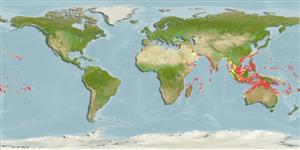| Native range | Year 2100 |

|
| Scomberoides lysan AquaMaps Data sources: GBIF OBIS |
Human uses
Fisheries: minor commercial; gamefish: yes; bait: occasionally
Phylogenetic diversity index
(Ref. 82805)
PD50 = 0.5625 many relatives (e.g. carps) 0.5 - 2.0 few relatives (e.g. lungfishes)
Trophic Level
(Ref. 69278)
4.0 ±0.67 se; Based on food items.
Resilience
(Ref. 69278)
Medium, minimum population doubling time 1.4 - 4.4 years (Preliminary K or Fecundity.)